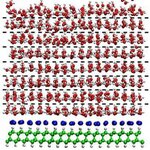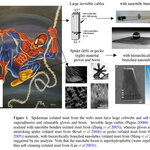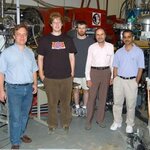Physics

Physicists at the University of Michigan have coaxed two separate atoms to communicate with a sort of quantum intuition that Albert Einstein called "spooky."
In doing so, the researchers have made an advance toward super-fast quantum computing. The research could also be a building block for a quantum internet.
Scientists used light to establish what's called "entanglement" between two atoms, which were trapped a meter apart in separate enclosures (think of entangling like controlling the outcome of one coin flip with the outcome of a separate coin flip).
"This linkage between remote atoms…

A recent simulation has shown that thin layers of ice could persist on specially treated diamond coatings at temperatures well above body temperature, which could make ice-coated-diamond films an ideal coating for artificial heart valves, joint replacements, and wear-resistant prosthetics.
Physicists Alexander D. Wissner-Gross and Efthimios Kaxiras of Harvard modeled water ice on top of a diamond surface coated with sodium ions. They found that ice layers should persist on the treated diamond up to temperatures of 108 degrees Fahrenheit (42 Celsius), and in some circumstances could remain…

While we are a long way off from the lightweight, high-performance, magical cloak of Harry Potter, physicists have been busy designing ways to make invisibility possible.
A recent theoretical analysis of a column-shaped invisibility cloak, by a collaboration of researchers from Sweden and China, showed that a cloak made to ideal specifications could render an object (or wizard) hidden inside perfectly invisible. However, even slight deviations from these specifications will cause the invisibility to break down.
The researchers analyzed the properties of a simulated tube of special…

A University of Leicester research team is working on a new technique for growing nanoparticles which could have extraordinary implications in electronics, medicine, the measurement of atmospheric air and the cleansing of car exhausts.
Dr Andrew Ellis and Dr Shengfu Yang, both of the University’s Department of Chemistry, have discovered a niche way of making nanoparticles that cannot be formed in any other way.
Working with Professor Chris Binns and Dr Klaus von Haeften in the Department of Physics and Astronomy, they are developing a technique involving the use of helium nanodroplets.
These…

Physicists have found the formula for a Spiderman suit. Recent research determined that van der Waals forces, the weak attraction that molecules have for each other when they are brought very close together, are responsible for the amazing sticking power of geckos and spiders. It is the tiny hairs on spiders’ feet that attract to the molecules of surfaces, even glass, and keep them steady.
Until this discovery it was doubted that a natural form of adhesion would ever be strong enough to hold the weight of real life 'Peter Parkers'.
Professor Nicola Pugno, engineer and physicist at…

Scientists conducting an experiment beneath the mountains of Italy have reached a clearer understanding of the sun's heart -- and of a mysterious class of subatomic particles born there.
The researchers, working as part of an international collaboration at the underground Gran Sasso National Laboratory near L'Aquila, Italy, have made the first real-time observation of low-energy solar neutrinos, which are fundamental particles created by nuclear reactions that stream in vast numbers from the sun's core.
Their measurements will be published in an upcoming edition of Physics Letters B and…

Researchers at Pacific Northwest National Laboratory are uniting theory, computation and experiment to discover exactly how heavy elements, such as uranium and technetium, interact in their environment.
As part of that effort, scientists have combined sensitive experimental measurements with fi rst principle electronic structure calculations to measure, and to really understand, the structural and bonding parameters of uranyl, the most common oxidation state of uranium in systems containing water.
The insights were achieved by PNNL scientist Bert de Jong and associates Gary Groenewold of…

Some materials change their electrical resistance in the presence of an external electromagnetic field. This concept is fundamental to data storage. Understanding large resistance changes, known as colossal magnetoresistance, could lead to new devices with increased data density and reduced power requirements.
"This is an extremely important piece of work with broad potential application in developing the next generation of electronic and data-storage devices," said Brookhaven physicist Yimei Zhu.
The Brookhaven scientists were studying crystalline perovskite manganites that had been doped…

Could extraterrestrial life be made of corkscrew-shaped particles of interstellar dust? Intriguing new evidence of life-like structures that form from inorganic substances in space are revealed today in the New Journal of Physics. The findings hint at the possibility that life beyond earth may not necessarily use carbon-based molecules as its building blocks. They also point to a possible new explanation for the origin of life on earth.
Life on earth is organic. It is composed of organic molecules, which are simply the compounds of carbon, excluding carbonates and carbon dioxide.
The idea…

For the past few months, members of the department of physics at Florida State University have begun using a groundbreaking new research facility to conduct experiments that may help provide answers to just such questions.
RESOLUT -- short for "REsonator SOLenoid with Upscale Transmission" -- is the name of the facility, which is located within the John D. Fox Superconducting Accelerator Laboratory on the FSU campus. Over the past few months, FSU researchers have begun using RESOLUT to create very rare, extremely short-lived radioactive particles similar to those that form inside exploding…